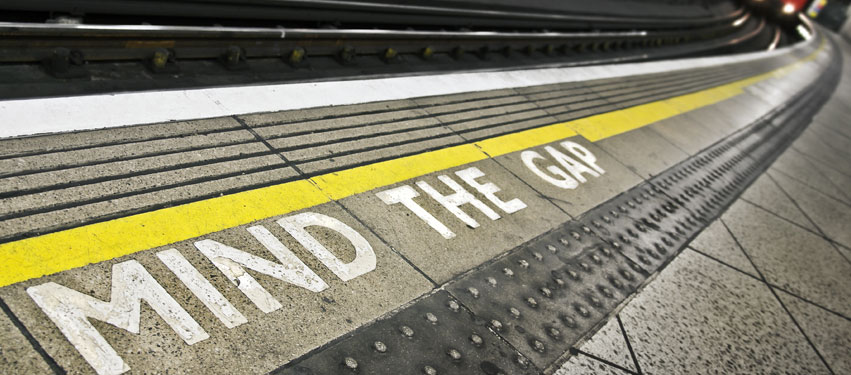
Those who travel to London and use its subway quickly become familiar with the signage “Mind the Gap,” which means “pay attention” to the gap between the platform and the train door. A lot can happen if one doesn’t mind the gap. Items can fall through and get lost on the tracks; people can trip or fall into the gap and suffer greatly.
The images of a train, a station, a platform gap and a train trip are good metaphors to talk about a community seeking a state of well-being for all its residents. Community well-being is the set of values, principles, policies and programs which enable everyone to reach their potential and fully contribute to a community. It is the journey all community residents are on individually, and these collective journeys contribute to the journey of our community as a whole.
Getting to the Station
In this community journey to reach a state of well-being, there is often a need for station stops along the way where “passengers” (residents) can get assistance. Those stops could include healthcare, education and training, employment opportunities, social and spiritual opportunities, and affordable housing.
Not everyone will need a stop, while others need many stops. Some assume they will never need a stop, but an unexpected accident, loss of job, health event or weather disaster can cause a major detour along life’s journey. One job of the human services industry is to help ensure that the various stations are available, accessible and well-managed. Each station may have many partners, such as government, private business and religious groups, as well as human service resources.
The human services industry also brings awareness to the community about which gaps exist that cause people to miss the train. What are those gaps to achieving well-being? A “passenger” may not be able to even get to the station to get on the train. Perhaps they can’t read, so they can’t understand the itinerary or schedule. They may not have the physical, emotional or intellectual capacity to get to the station. Maybe they can’t afford a ticket. Even if they get to the platform, they may fall into the gap of fear of the journey, or get pushed aside by another passenger, or feel ineligible to ride due to rules and regulations.
How does the human services sector help passengers step over the gaps and get to the stations they need and desire? Because no single entity can fix everything for everybody, an important role of human services is to extend, expand and enhance the resources provided by government and business partners so that everyone gets on the train and has a successful journey.
Destination: Community Well-Being
Here are a few examples of how human services fill the gaps in our community so that everyone can get on the train, so that all the stations are the best they can be, and so the destination of community well-being is clearly defined. When this happens, we all benefit. Human services partner with schools by providing:
- Tutors in reading and math;
- Afterschool programs to help children grow and allow parents to work;
- Summer camps to teach soft skills in
communication, relationship building, etc.; - Schooling for children with special needs; and
- Violence and abuse prevention education classes.
Human services partner with healthcare by providing:
- Treatment not available through government
or employer-provided insurance; - Classes in wellness, fitness, nutrition and coping skills;
- Behavioral health services;
- Crisis centers and advocates to alleviate ER usage; and
- Vaccination stipends.
Human services partner with for-profit businesses by providing:
- Classes in job readiness and job retention skills;
- Capable workforce candidates who may include adults
with disabilities; and - Affordable child care.
Human services partner with government by providing:
- Enhancement of government contracts through additional fundraising;
- Court advocates who help at-risk adults and children;
- Training for criminal justice professionals;
- Affordable housing; and
- Foster care oversight.
The Human Services Collaborative is thankful that the Peoria area has so many wonderful “train engineers”—such as community leaders, teachers, religious leaders and public safety officials. Collaboration with others is the engine that gets us to well-being for all.
The Collaborative is also thankful to the many professionals on our human services staffs, including social workers, counselors, advocates, child care workers, recreational instructors, job coaches and more. Collectively, they make up the area’s fifth-largest employee group and are dedicated to enriching thousands of lives. They are all chugging away, every day, to reach the destination of well-being for all.
The Journey Continues...
What are the next legs of the journey to community well-being? Perhaps new stations need to be built or current ones remodeled. Perhaps gaps can be bridged in new ways so no one falls through the cracks. Perhaps unengaged passengers can be encouraged to get on the train, or new partnerships can be formed to streamline the journey.
The purpose of the Human Services Collaborative is to spark the conversation with all community stakeholders about the goal of well-being for all. Everyone is welcome to get on board for the journey to community well-being.
Members of the Collaborative welcome input from one and all. To learn more, visit humanservicescollaborative.com, as well as the websites of its individual agency members. PM
- Log in to post comments

